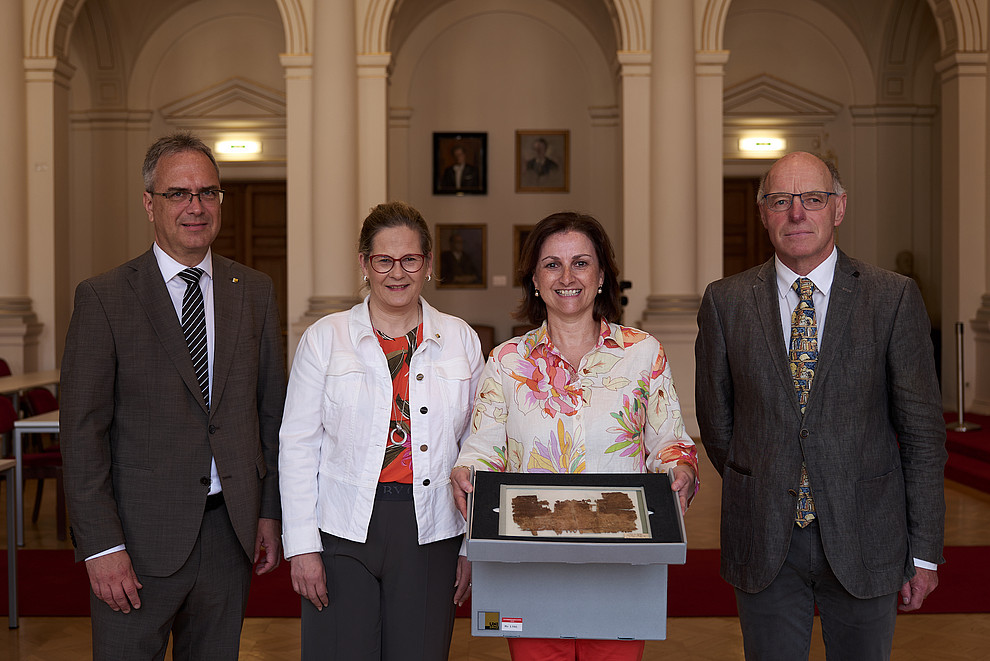Theresa Zammit Lupi made international headlines this week when she upended established wisdom on the history of books by discovering evidence of binding in papyrus used to wrap an Egyptian mummy.
The “serendipitous” discovery shows that codices – that is, sheafs of papyrus, vellum or other materials with bindings running through the centrefold, rather than single flat pieces that could be rolled up into scrolls – existed as far back as 260 BC.
A codex can be understood as the ancestor of the modern book, which is made of paper.
The previous objects with a claim to the title of “oldest book in the world” date to 150 AD to 250 AD.
Dr Zammit Lupi’s find therefore predates them by around 400 years, prompting the conservator to quip that she “felt like Indiana Jones”.
“I never imagined something like this could happen to me in my career and it really is a once-in-a-lifetime chance,” she said.

Theresa Zammit Lupi (second from right) presents the discovery. Photo: Uni Graz/Kernasenko
The discovery was made during her routine work as Head of Conservation of the Special Collection at the University of Graz in Austria, while she was inspecting a fragment originally found in 1902 in El Hibba, Egypt.
Dr Theresa Zammit Lupi explained that the fragment was first part of a notebook, and includes legible Greek text describing beer and oil taxes. It was later recycled as wrapping for a mummy.
With the world’s attention fixed on her work, WhosWho.mt went to find out more about the Maltese conservator behind the discovery.
Dr Zammit Lupi describes herself as “a book and paper conservator who is passionate about historic bindings and illuminated manuscripts”.
On her Academia.edu profile, she writes: “I am fascinated about the detail that one finds in book structures that can provide new meaning to the history of the book.”
She was one of the first cohorts to study History of Art at the University of Malta after the course was set up by Professor Mario Buhagiar, following which she studied book and paper conservation in Florence at the Istituto per L’Arte e il Restauro, Palazzo Spinelli.
In 2002 she was awarded an MA in conservation from Camberwell College, and completed her PhD at the same college in 2008.
Her doctorate research, on a collection of 16th century illuminated musical manuscripts housed at St John’s Co-Cathedral, led to the publication of a book, Cantate Domino: Early Choir Books for the Knights in Malta. The manuscripts are known as L'Isle Adam's Graduals, after the Grand Master who first brought the Knights of St John to Malta.
She has co-authored a number of book chapters and papers since then.
Dr Zammit Lupi has also conducted crucial work for Malta’s National Archives, where she undertook a careful restoration of the Cantilena – the oldest piece of Maltese writing, dating back to pre-1485.
Growing up in a “lively household” as one of four children, Dr Zammit Lupi’s early years provided the artistic impetus that led her to follow her passion.
In a 2021 podcast with Fondazzjoni Patrimonju Malti, she said that she knew she wanted to be a conservator when she was 17, while studying languages at post-secondary level. Unenthused by the prospect of a career in law, her interest was sparked by a National Geographic article on the restoration of the Sistine Chapel in the Vatican.
“I was awed! I said, that’s it, I want to become a conservator.”
Main Image:Theresa Zammit Lupi with one of the L'Isle Adam manuscripts in 2011. Photo: Joe P. Borg / Fondazzjoni Patrimonju Malti
